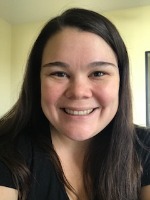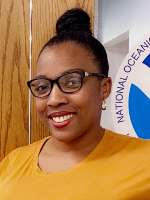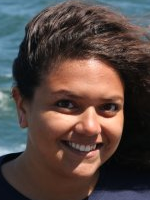Scott B. Gudes Public Service Graduate Scholarship in Marine Resource Conservation
This scholarship is awarded to a master’s or doctoral student pursuing a degree in a NOAA Fisheries related discipline whose research has a strong potential to contribute to the advancement of marine resource conservation and who has played an exemplary role in public service.
The LMRCSC has awarded three Scott Gudes scholarships since 2017. Recipients were selected competitively based on the following criteria: (1) Full time graduate student conducting research at the LMRCSC relevant to marine resource conservation (2) Have and maintain a cumulative 3.5 GPA, (3) Demonstrated scholastic and leadership achievements, (4) Service to the EPP/MSI Cooperative Science Center and the fisheries community, and (5) Must be a US citizen and a CSC supported student. Information on the recipients are presented below:
2024- 2025
Institution: University of Miami RSMAS
Degree Level: Ph.D. (Marine Science)
Amount of Fellowship: $42,000/yr
Project Title: Estimating Fish Abundances and Relationship with Habitat using Baited Remote Underwater Video Surveys in the Biscayne Bay
NERTO Title: Spatial modeling of diets, predation, and the pelagic food web of the California Current
Current Position: Graduate Research Assistant; plans to complete his degree by August 2025
Institution: University of Miami RSMAS
Degree Level: Ph.D. (Marine Biology & Ecology)
Amount of Fellowship: $42,000/yr
Project Title: Characterization of fisheries interactions with blue marlin and yellowfin tuna in the Inter-American Seas since the Deepwater Horizon oil spill
NERTO Title: Analysis of batoid bycatch from the Delaware Bay COASTSPAN (Cooperative Atlantic States Shark Pupping and Nursery) Surveys
Current Position: Graduate Research Assistant; plans to complete her degree by December 2026
2021- 2022
Institution: University of Maryland Eastern Shore
Degree Level: Ph.D.
Amount of Fellowship: $35,000/yr
Project Title: Ecosystem Model of the Maryland Coastal Bays: The influence of climatic factors on biomass distributions of fish and macroinvertebrate species, food web linkages, and ecosystem structure
NERTO Title: Development of an Ecosystem Model for the Maryland Coastal BaysCurrent Position: NOAA National Oceanographic Partnership Program (NOPP) Program Management Support with Integrated Systems Solutions, Inc. (ISS).
Kasondra successfully defended her dissertation in fall 2022. She has also co-authored two peer-reviewed publications:
- Boyer, J., Rubalcava*, K., Booth, S. and Townsend, H., 2022. Proof-of-concept model for exploring the impacts of microplastics accumulation in the Maryland coastal bays ecosystem. Ecological Modelling, 464, p.109849.
- Jesse, J.A., Agnew, M.V., Arai, K., Armstrong, C.T., Hood, S.M., Kachmar, M.L., Long, J.T., McCarty, A.J., Ross, M.O., Rubalcava, K.D.*, Shaner, J., Tanaka, S., Wood, L., Schott, E., and Wilberg, M. (2021). Effects of Infectious Diseases on Population Dynamics of Marine Organisms in Chesapeake Bay. Estuaries and Coasts, pp.1-16. doi: 10.1007/s12237-021- 00915-4.
2018 – 2019
Institution: University of Maryland Center for Environmental Science – IMET
Degree Level: Ph.D.
Amount of Fellowship: $35,000/yr
Project Title: Investigating the Reproductive Biology and Endocrinology of the Female Red Deep-Sea Crab, Chaceon quinquedens
NERTO Title: Striped Bass Habitat Indicator for Chesapeake Bay
Current Position: Completes her Ph.D. in spring 2022; currently works in NOAA Office of Education, Environmental Literacy Program as a Grant Specialist
Other Information: She completed a year of Knauss Fellowship at NOAA’s Climate Program Office
Shadaesha’s NERTO project focused on developing a conceptual model indicating factors impacting juvenile striped bass nursery habitat and preparing the ‘Chesapeake Bay striped bass nursery habitat assessment’ Request-for-Proposal (RFP) for submission to the Chesapeake Bay Trust. During the work, she interacted with many fishery managers and scientists in the Chesapeake Bay region and gained valuable experience on fishery policy. She has co-authored two peer-reviewed publication on the biology of red deep-sea crab.
- Lawrence, A., Green, S. & Chung, J.S. (2017). Isolation and Tissue Distribution of an Insulin-Like Androgenic Gland Hormone (IAG) of the Male Red Deep-Sea Crab, Chaceon quinquedens. Marine Drugs 15(8): 241.
- Huang X, Green S, Sook Chung J. (2021). The presence of an insulin-like peptide-binding protein (ILPBP) in the ovary and its involvement in the ovarian development of the red deep-sea crab, Chaceon quinquedens. General Comparative Endocrinology. 301:113653. doi: 10.1016/j.ygcen.2020.113653
2017 – 2018
Institution: University of Maryland Eastern Shore
Degree Level: Ph.D.
Amount of Fellowship: $35,000/yr
Project Title: Reproductive Biology of Female Red Deep-Sea Crab, Chaceon quinquedens, in the Mid-Atlantic Bight
NERTO Title: Eastern Bering Sea Crab Survey
Current Position: Graduated and is employed as Fishery Biologist at NOAA SEFSC, Miami, FL
Stephanie gave a presentation of her work to Mr. Scott Gudes during his visit to UMES, but we have not made further communications with Mr. Gudes since that time. She authored two peer-reviewed publications on the biology of a commercially important shellfish species.
- Martinez-Rivera, S., Long, W.C. and Stevens, B.G. 2020. Physiological and behavioral sexual maturity of female red deep-sea crabs Chaceon quinquedens (Smith, 1879) (Decapoda: Brachyura: Geryonidae) in the Mid-Atlantic Bight. Journal of Crustacean Biology. 40(3):330-340.
- Martinez-Rivera, S., Stevens, B.G. 2020. Embryonic development and fecundity of the red deep-sea crab Chaceon quinquedens Smith, 1879) (Decapoda: Brachyura: Geryonidae) in the Mid-Atlantic Bight determined by image analysis. Journal of Crustacean Biology. 40(3):230-236.







